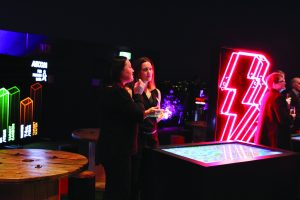Disruptive technology and beating the traffic
Have you ever been stuck in traffic and thought “I could do a better job at transportation planning here?”
To put this to the test, a table-top digital simulation game called Reconnected City was created for Vivid Sydney 2015, a creative festival of light, music and ideas in the Australian city. The game’s players were challenged to improve traffic congestion in a virtual city while keeping its capital costs, as well as water and energy consumption, in balance.

The game was featured in the Reconnecting Sydney event. As part of this, a panel of experts discussed the question: “How will emerging technology connect Sydney and change the way we move?” Panelists included global visionaries such as Raj Vaswani, co-founder of Silver Spring Networks, and a networking technology specialist, who said the most significant change in the coming 50 years will be the rise of machine automation. “Technological trends will continue to create more and more possibilities for things to be connected, monitored, controlled, and integrated. These massive scale, interoperating machine networks will radically augment our environment, improving health, safety, comfort, convenience and control,” he said. Co-founder of think tank Future Crunch, Dr. Angus Hervey, said with the predicted advance of telemetry and associated technologies such as driverless cars, Sydney may not need as many roads or train lines. “This technological disruption, which is part of the larger digital revolution, will mean most cars become a lot more efficient thanks to more effective driving algorithms. That means better traffic management and more passengers per car trip.” He also said “Sydney is spending billions of dollars on roads that may not be necessary. Surely the city could get more bang for its buck by investing in something like the world’s most advanced data center, as China is currently doing?”
The panel event was hosted by AECOM, which created the game with the creative technology agency S1T2, using data drawn from AECOM’s Sustainable Systems Integration Model (SSIM). SSIM is an integrated Geographic Information System-based design, planning and feasibility tool. It was developed to help decision-makers and others to evaluate the numerous alternatives for balancing social, environmental and economic priorities and impacts, while ensuring a sound assessment of costs and benefits. “We need to be flexible in our approach to planning the future of Sydney,” said AECOM’s James Rosenwax, managing director, design + planning, Australia and New Zealand. “With the advancement of technology to connect and move us, change and disruption will be very high on the agenda. Certainty in Sydney should come from the delivery of a well-integrated transport network, and we should be prepared to allow for innovation in how we live, work and play in and around this network.”






